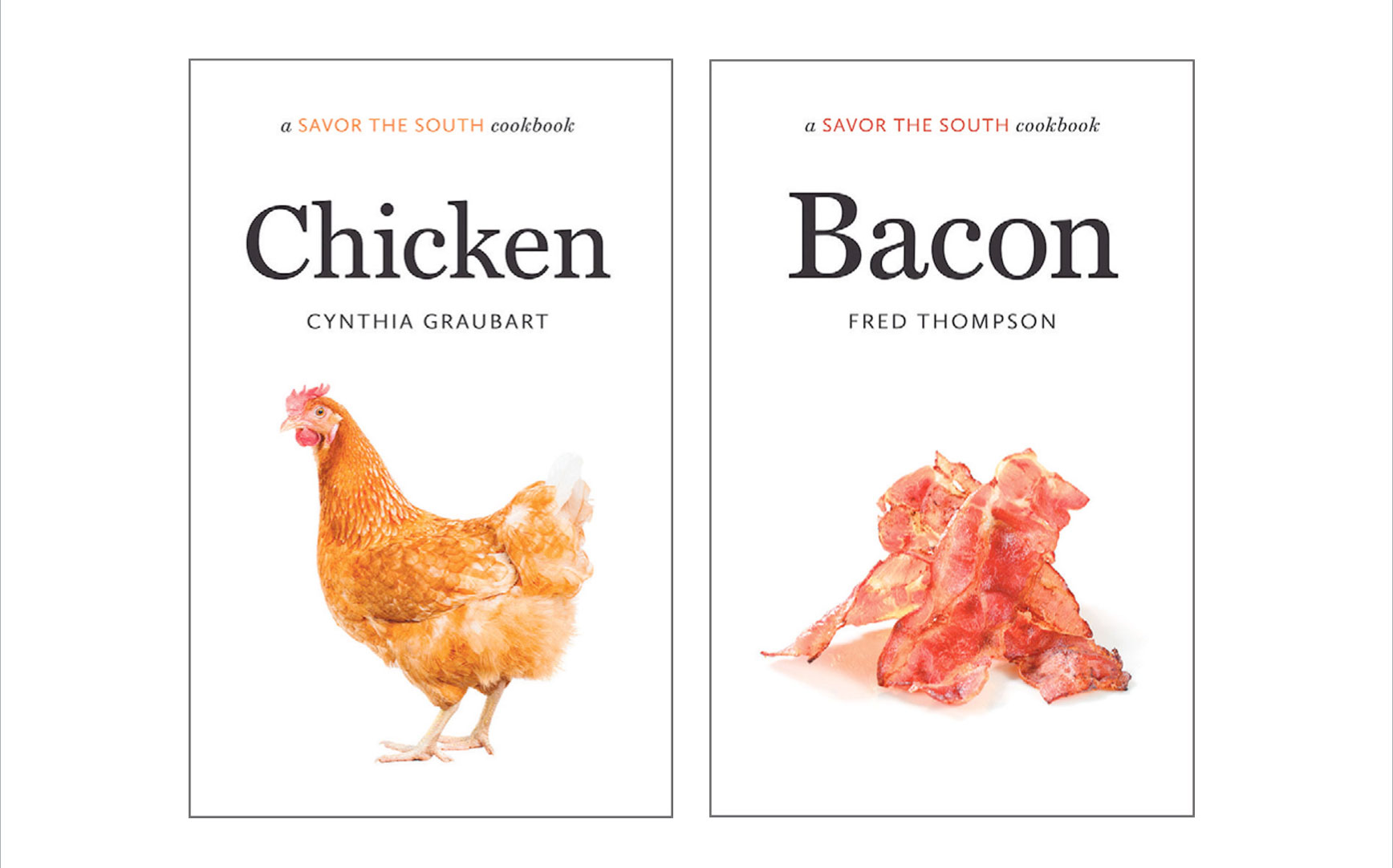Edible Ink
In September, UNC Press added two titles to its impressive and highly collectible set of single-topic Savor the South Cookbooks: Bacon by Fred Thompson, author of Southern Sides and publisher of this magazine, and Chicken by Cynthia Graubart, who is perhaps best known as Nathalie Dupree’s co-writer in the James Beard Award-winning Mastering the Art of Southern Cooking and its companion, Mastering the Art of Southern Vegetables.
Bacon
Thompson’s collection of 56 recipes covers both the scope of bacon’s beloved status in the southern kitchen and its presence in global cuisines. While records track it back to ancient Chinese dynasties, it is in the rural and pre-supermarket South that home-cured bacon, like most proteins, achieved its apex as both a seasoning and center-of-the-plate feature and an everyday essential. Unlike even more precious chicken and beef, renderings of cured pork — especially the fatty belly traditionally used to make bacon — was virtuously collected in repurposed coffee tins and used daily to fry food or make the most tender biscuits and pie crusts.
The introduction is loaded — dare we say larded — with bacon’s intriguing back story. The Raleigh author posits that is among our most democratic foods: “Most anyone in our population can afford some kind of bacon. While most of the major meatpacking companies have fiddled with it some, they have been unable to destroy the essential truth in bacon. Even in the face of mega-industrial food landscape, small packers offering artisanal bacons have found their place on the grocer’s meat counter.”
Our love affair with bacon endures despite occasional reports by health organizations that we should minimize consumption due to the presence of potentially carcinogenic nitrates, which are present in most processed meats. Like a siren’s song, its crisp, umami-rich flavor and tantalizing aroma always beckons, breaking the resolve even of many a vegetarian.
If you are among those who regularly attend the church of bacon, Bacon will be a welcome hymnal. In addition to the essential chapter on convincingly simple DIY bacon, which also includes Canadian bacon and pancetta, be sure to try one of Thompson’s confessed favorites, the Slow Cooker Bacon Jam (see recipe). Featured in the Party Favorites chapter, this versatile condiment could not be simpler to make and, packed in little jars, makes a fine gift.
Other standout temptations include the breakfast-friendly Bacon Sour Cream Coffee Cake with Maple Glaze, a recipe created by Edible Piedmont editor Belinda Ellis; Chesapeake House Fish Stew, contributed by the namesake restaurant in Myrtle Beach; the indulgent 50/50 Burger, which combines ground chuck with ground slab bacon; and amped-up Chocolate Chip Cookies with Bacon.
Chicken
Atlanta-based Cynthia Graubart takes a similarly comprehensive approach in Chicken. Gratefully, however, she does not suggest any chicken-based desserts.
While filled with appealing recipes, Graubart’s volume is distinct from other Savor the South books for its luxurious head notes, which sometimes share scholarly detail but just as often feature family humor. Don’t miss the secret ingredient that made a newly converted bride’s fluffy matzo balls so memorable at her first Seder.
Indeed, Graubart sets an affectionate tone for her topic right away with an early childhood memory of standing in a long line for supremely good fried chicken. Claiming she learned to cook “in self defense” of her mother’s penchant for recipes reliant on canned creamed soups, her horizons widened considerably when she landed a job producing Nathalie Dupree’s popular 1980s PBS series, New Southern Cooking. From a Piedmont perspective, it’s endearing to see Graubart gratefully name-drop locals who shared or inspired recipes, including Sheri Castle, Nancie McDermott, Sandra Gutierrez and April McGreger.
Since Americans consume 85 to 90 pounds of chicken annually, they all should keep this book within easy reach. Its 53 recipes are divided into whole bird, cut-up chicken, and cooked or leftover chicken categories. For best flavor and even cooking, Graubart urges readers to choose smaller, 3-to-3.5 pound birds that have been humanely raised over their big-breasted commercial cousins that sometimes weigh in excess of 6 pounds.
While Graubart observes that “a sign of a great cook is his or her ability to roast a chicken” — one trick for a juicy bird is to cook it upright in a Bundt pan — her recipes represent a love affair with all southern classics. Her empowering notes on Crispy Fried Chicken will make you want to fix some right away; if you can get your hands on muscadines, save some for Roasted Chicken Thighs with Muscadines, in which the thick-skinned grapes provide sweet contrast to savory Kalamata olives.
Other recipes reflect the influence of immigrants who now call the South home. Her Chicken Makhani (Butter Chicken) will make you put down the Indian take-out menu and Chicken Parmesan Patti will turn your kitchen into the best Italian-America eatery on the block. Maybe you’d prefer Korean Twice-Fried Chicken Wings? Yes, please.
For now, consider her Chicken Pot Pie (see recipe), a fall classic as sure to please family and friends.
Related local event:
Cynthia Graubart will teach a class based on Chicken at 6 p.m. November 4 at the Southern Season Cooking School in Chapel Hill. For details or to register, call 919-929-7133.





